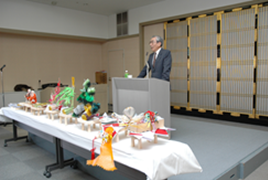Exploring the essence of Kyoto culture through the yellow and white mizuhiki rituals unique to Kyoto (Part 1)
~Black and white from Tokyo is a culture that clearly separates life and death in samurai culture.
The original yellow and white Mizuhiki of Kyoto is a color culture that soothes the sadness of the court noble culture.~
Yoshie Doi
 |
 |
 |
 |
 |
Engagement mizuhiki from Genda Paper Industry, founded in the Nara period
Kyo-Suzume School held on March 19, 2006
At Nishi Honganji Monpo Hall
Lecturer: Mr. Yoshiro Genda
A photo of the original betrothal mizuhiki
On March 3, 2024, an article was published in the Kyoto Shimbun stating that “Kyoto’s original yellow and white Mizuhiki is no longer used for Buddhist services.” It is true that more and more people are using black and white Mizuhiki in Kyoto these days. In this blog, I would like to trace the history of why yellow and white mizuhiki were used in Kyoto.
On March 19, 2006, we held a course called “Learning from the cultural history of Mizuhiki” under the curriculum of “Kyoto Kiki Monogatari” at “Kyo-Suzume School.” The lecturer will be Mr. Yoshiro Genda, President and CEO of Genda Shigyo Co., Ltd. Founded in 771 (Hoki 2nd year, Nara period). Although the business is currently closed, the company still exists. Mr. Genda is living in Australia, and when he returned to Japan, he had a lecture.
I would like to introduce you to what I learned about the cultural history of Mizuhiki.People spend their lives celebrating the birth of a child, celebrating a birth, visiting a shrine, the first meal, the first festival, Shichigosan, 13th festival, etc. Admission, graduation, betrothal, marriage, 60th birthday, Koki (70 years old), 77 years old (Kiju), 80 years old (Kasaju), 88 years old (Beiju), 90 years old (Graduation life), 99 years old (Hakuju) Hyakusai
(Momoga), etc. Japanese people are a people who love to celebrate with great care. Mizuhiki itself is just a string, but its original form is one that has been dyed white and red.
According to legend, in the early 7th century (Asuka period), when Ono Imoko received a souvenir from the Zui Dynasty, this mizuhiki was tied to a hemp cord that was dyed red and white. This may be the root.
At that time, the twine was called “kurenai”. The first recorded mention of it is that it was written in the Engishiki, compiled in the Heian period, as “a gift of soshi from Ina District.”
In Japan, an agricultural culture, there is a custom of bundling and tying straw as offerings to the gods during rituals, so tying has a meaning, and it means putting one’s heart and soul into it.
Under the influence of these envoys to the Zui Dynasty, it seems that it became customary to tie red and white hemp cords around tributes to the aristocrats and the imperial court. Etymologically, kouhaku represents the yin and yang of the lunar calendar, and it is called mizuhiki because red and white mizuhiki, curtains, and water are used to separate the sacred areas from the general public. It is also said that red and white mizuhiki, which was invented as a decoration for gifts in the imperial court during the Heian period, was called “kurenai” because the highest quality lipstick was used as the dye at the time.
Additionally, mizuhiki was only used in the imperial court, and koyori were made by court ladies. There is also a theory that when making the koyori, the koyori was squeezed with the spittle, which caused the lady-in-waiting’s lipstick to get on and turn red.
The origin of koyori is to paint white with white powder, make a 30-shaku (9 mm) piece of chalk and glue, tighten the glue, and then pull it out, and use water to prevent it from drying out. During the Heian period, when aristocrats enjoyed waka poetry, they dyed “Kurenai” purple or yellow and used it to bind their poetry collections. It is said that this hemp string became paper string around the Muromachi period, and it became popular among the common people in the Edo period.
Part 2 continues next week
The end of document
Translated by Masami Otani
